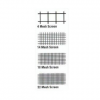I am deciding on a new turret cam. I read the threads about the two cameras. They both have the same sensor size but one is 4MP and the other one is 8MP. I understand that in most cases you want to go with the lower MP to have less noise (unless you have a really well lit area where the 8MP cam still gives you good video streams). But even if the brightness isn't that great, why would you chose a 4MP over an 8MP cam? All cameras have different settings to go to lower resolutions. I understand this isn't done on the HW level (you can't change the pixel size) but in SW (combining pixels). But even if this is done after the AD conversion (so in software) you should still get a better SNR/lower noise by lowering the resolution.
I guess my question is, if you lower the resolution of a 8MP cam to 4MP is it still noticeably worse than a camera that natively is 4MP? If not and the price is the same then I guess the 8MP gives you more flexibility in case your needs/lights/etc changes.
I guess my question is, if you lower the resolution of a 8MP cam to 4MP is it still noticeably worse than a camera that natively is 4MP? If not and the price is the same then I guess the 8MP gives you more flexibility in case your needs/lights/etc changes.




